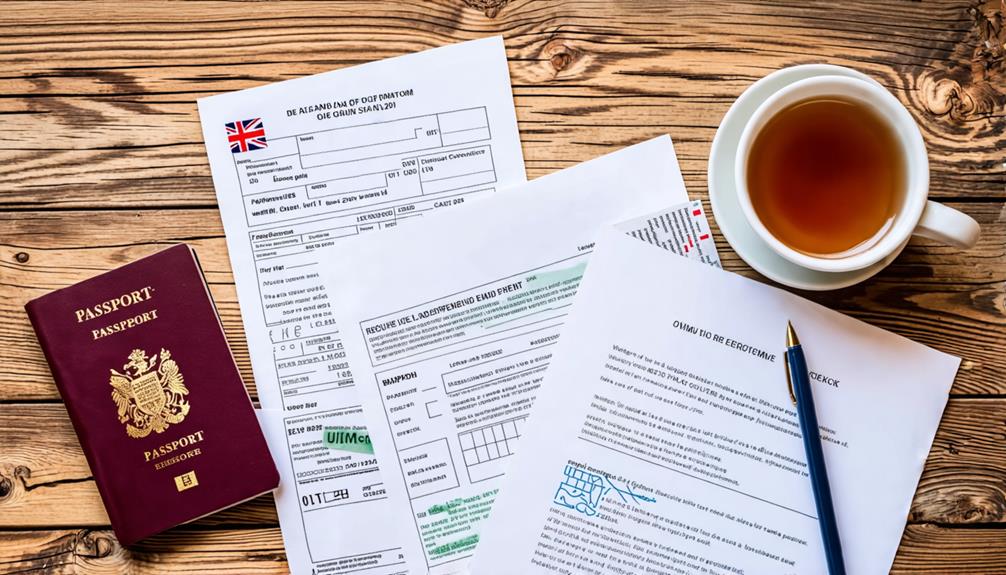The process to obtain UK Baseline Personnel Security Standard (BPSS) clearance requires submitting several key documents.
These include proof of identity, which can be a passport or UK driver’s license, and right to work documents such as a valid UK passport or Home Office paperwork.
You will also need to provide employment history records that cover a minimum of three years, educational qualifications, and self-employment verification if applicable.
Special circumstances like career gaps must be substantiated with appropriate evidence, for example, maternity or military service records.
Depending on individual backgrounds, additional documents may be needed for thorough verification.
Familiarity with these requirements can aid in a successful BPSS clearance.
Proof of Identity
UK BPSS clearance demands the provision of original, valid documents such as a passport or a UK driver’s license for proof of identity. These documents play a vital role in establishing an individual’s identity, confirming that the person is who they assert to be.
The insistence on original documents over photocopies is a principal method to curb identity fraud and uphold the integrity of the BPSS (Baseline Personnel Security Standard) clearance procedure.
For individuals who are not UK nationals, supplementary documentation demonstrating residency, like a Home Office document, is required. This further step verifies not just their identity but also their lawful right to live and work in the UK.
The provision of these documents is painstakingly inspected to affirm compliance with UK laws.
The identity verification process under BPSS includes a preliminary Disclosure and Barring Service (DBS) check as well. This check is conducted to uncover any unspent criminal records tied to the individual’s identity, adding another layer of protection to the security of the workplace.
Right to Work Documents
Verifying an individual’s Right to Work documents is a foundational requirement for confirming their legal eligibility to work in the UK. This validation is a critical element of the Baseline Personnel Security Standard (BPSS) clearance process. Employers are required to affirm the authenticity and validity of these documents prior to the commencement of employment. The main aim is to mitigate illegal employment and protect national security.
Here are the primary components of Right to Work documentation:
- UK Passport or Home Office Document: A valid UK passport or a relevant document from the Home Office confirms an individual’s right to work instantly.
- Proof for Non-UK Nationals: This includes visas, biometric residence permits, or EU Settlement Scheme status. Non-UK nationals need to reveal their residency and immigration status.
- Original Documents: Employers should review original documents; photocopies or expired documents do not fulfill the verification standards.
- Obligatory Checks: Performing a Right to Work check is mandatory and must be fulfilled before any employment starts. Failure to comply can result in severe consequences, including substantial fines and potential legal action against the employer.
Employment History Records
After validating an individual’s Right to Work documents, the subsequent step in the BPSS clearance process is to confirm their employment history records. This validation requires documentation that covers at least three years of uninterrupted employment. Key documents encompass payslips, P60s, and P45s, collectively offering comprehensive evidence of an individual’s employment and income status.
Payslips are particularly vital as they deliver proof of employment and consistent income, ideally covering the most recent three-year period. A P45 form is useful for verifying the termination of employment with previous employers, and a P60 confirms earnings and tax deductions for a specific tax year.
Additionally, individuals should assemble PAYE records and HMRC/National Insurance tax records. These records are indispensable in verifying employment history during the BPSS check.
In situations where an individual has been self-employed, they must supply self-assessment tax returns, invoices to clients, and bank statements indicating payments from clients. These documents collectively create the necessary employment history, making sure that the BPSS clearance process is comprehensive and precise.
Each document contributes uniquely to presenting a holistic view of the individual’s employment background, thereby simplifying the clearance process.
Education and Qualification Proof
For BPSS clearance, providing proof of the applicant’s educational background is fundamental. This involves submitting various documents from reputable educational institutions that confirm their academic accomplishments. These documents are instrumental in authenticating the educational qualifications and confirming the applicant is eligible.
Key documents necessary for BPSS clearance encompass the following:
- Certificates from Recognized Educational Institutions: These are official documents such as diplomas or degrees affirming the completion of educational programs. They authenticate the academic credentials of the applicant and their alignment with BPSS criteria.
- Student Transcripts: These are comprehensive records of courses undertaken and grades attained. Transcripts present a detailed insight into the applicant’s academic history and performance, thereby reinforcing the credibility of their qualifications.
- Student Loan Letters: These documents provide additional proof of the applicant’s enrollment and dedication to their educational programs. They support the timeline and duration of the applicant’s academic journey.
- Education Correspondence: These are letters from educational institutions verifying attendance and qualifications. They confirm the accuracy and verifiability of the applicant’s educational history, adding more authenticity to their profile.
The provision of well-organized and transparent educational documentation is key for a seamless BPSS verification process and effectively communicates the applicant’s dedication and qualifications.
Self-Employment Verification
For BPSS clearance, validating self-employment requires the submission of Self-Assessment Tax Returns to demonstrate income and tax compliance.
Additionally, client invoices and bank statements highlighting received payments are required to verify continuous business activity and financial health.
These documents together form a comprehensive and clear record of self-employment, contributing to a more efficient clearance process.
Self-Assessment Tax Returns
Self-Assessment Tax Returns are crucial for verifying self-employment status and income during the BPSS clearance process in the UK. These returns, which are submitted annually to HMRC, contain detailed information on income, allowable expenses, and any tax relief claimed. For self-employed individuals, it’s important to provide accurate Self-Assessment Tax Returns for the past three years to show compliance and financial integrity during the BPSS verification process.
For a comprehensive submission, consider these key elements:
- Detailed Earnings: Offer a comprehensive account of your income, including any business-related revenue.
- Allowable Expenses: Record all expenses that you can legally deduct from your income, like business travel, office supplies, and professional services.
- Tax Relief Claimed: Mention any tax reliefs you have claimed, which may include deductions for pension contributions or specific business investments.
- Access via HMRC Portal: Use the HMRC online portal to access and submit your Self-Assessment Tax Returns securely. This ensures that all records are current and easily accessible.
Client Invoices
Client invoices are crucial documents used for verifying self-employment during the BPSS clearance process. They provide concrete proof of income from clients over a defined time frame. The invoices should clearly outline the date of service, a summary of the work carried out, the fee charged, and the client’s details to ensure accurate identification and validation.
Keeping a clear and well-organized record of all client invoices is recommended for showcasing continuous business activity and fiscal stability, both of which are key factors during the BPSS check. These records can supplement other self-employment verification methods, thereby boosting the overall trustworthiness of the applicant’s self-employment status.
Invoices that are properly structured and detailed can significantly ease the verification process. They offer a clear picture of the business transactions, thus helping to validate self-employment claims. By including all necessary information and keeping an organized system, applicants can portray a dependable and professional image, which can subsequently help BPSS assessors and speed up the clearance process.
Payment Bank Statements
Payment bank statements assist in verifying self-employment status during the BPSS clearance process by showing a consistent client income. These documents support an applicant’s financial stability and employment history. To meet the BPSS guidelines, payment bank statements should ideally cover a minimum period of three years. This timeframe aids in establishing a continuous and reliable income source, reinforcing the individual’s self-employment status.
Key factors for using payment bank statements in the BPSS clearance process include:
- Consistency: Verify that the bank statements show regular payments received from clients or customers. This shows a steady income flow and confirms ongoing self-employment.
- Source Identification: The income source should be clearly marked on the statements. Payments should be traceable to specific clients or customers, promoting transparency and authenticity.
- Match with Other Documents: Bank statements need to align with other financial records such as invoices and self-assessment tax returns. Consistency across these documents bolsters the verification package.
- Addressing Gaps: Any inconsistencies or gaps in bank statements can raise questions. Providing explanations for any anomalies is key to prevent delays or complications in the clearance process.
Special Circumstances Evidence
Additional evidence is necessary in some cases for applicants applying for BPSS clearance, especially when there are gaps in their career or special circumstances.
For example, individuals who have been on maternity leave can clarify the reason for their employment break by submitting supporting documents like a birth certificate or proof of child benefit payments.
For those who have served in the military, the period of service can be verified through a Certificate of Service or an HM Forces ID, ensuring that the time they spent in the military is accounted for in the BPSS evaluation process.
Career gaps that are longer than 31 days need to be supported with suitable evidence. This could be letters confirming receipt of unemployment benefits or documentation of job applications, which can give insight into the applicant’s activities and intentions during periods where they were not employed.
For individuals who have spent more than six months travelling in the last three years, they are required to provide visas, passport stamps, or receipts. This documentation is necessary for proving their overseas stays and is used in the BPSS assessment.
Voluntary work can also serve as a reason for employment gaps, and applicants can provide written proof from the relevant organizations to account for this. This documentation is required for a comprehensive review of the applicant’s history.
Additional Documentation
In some scenarios, applicants might have to produce extra documentation to cater to unique situations or to avail more services provided by the BPSS procedure.
For example, persons with distinct work backgrounds or significant overseas travel might need to furnish additional proofs.
Plus, expert verification services could aid in making sure all paperwork aligns with the required norms.
Special Circumstances Evidence
Special circumstances evidence has a significant role in validating career gaps and unique life events during the BPSS clearance process. This type of documentation ensures that all periods of an individual’s employment history and personal life are transparently accounted for, giving a comprehensive view of their background.
To facilitate understanding, here are four key types of special circumstances evidence:
- Career Gaps Over 31 Days: For individuals who have experienced employment gaps exceeding 31 days, documentation such as job applications or letters from previous employers is necessary to support these periods. This helps to confirm that the gaps were legitimate and accounted for.
- Maternity Leave: Evidence of maternity leave can be provided through birth certificates or child benefit payment records, confirming the time taken away from work for childbirth and caregiving responsibilities.
- Military Service Verification: Individuals who have served in the armed forces can provide an HM Forces ID or a Certificate of Service. These documents confirm the duration and nature of their military service, contributing to a complete employment history.
- Redundancy Documentation: In cases of redundancy, evidence such as P60/P45 forms and redundancy paperwork is required. This documentation validates interruptions in employment due to organizational downsizing or economic conditions.
Properly submitted special circumstances evidence ensures a smooth BPSS clearance process, maintaining the integrity and accuracy of an individual’s background check.
Additional Services Offered
Employers can contribute to the success of the BPSS clearance process by offering extra services such as guidance on how to submit documents and maintaining GDPR-compliant storage for all relevant records. These services are crucial in making the verification process more efficient and ensuring all security protocols are followed without any breach of personal data.
For roles that necessitate security industry accreditation, an SIA license is obligatory. Employers can assist in this by guiding candidates through the SIA licensing process, confirming that all required qualifications are met.
Organizations can also offer services to help candidates download PAYE records at no cost. This help is significant in verifying employment history, a main component of the BPSS clearance. By providing clear instructions and support, employers can significantly reduce the complexity and time spent in gathering necessary documentation.
Ongoing support for navigating the complexities of BPSS checks can be very valuable for businesses. This includes maintaining all records securely in compliance with GDPR regulations, which not only safeguards candidates’ personal data but also strengthens the reliability of the BPSS clearance process.
Such comprehensive services highlight the employer’s dedication to thorough and compliant screening practices.
Conclusion
The UK Baseline Personnel Security Standard (BPSS) clearance process requires several important documents. These include proof of identity, right to work documents, records of employment history, and documentation of education and qualifications.
Verification of self-employment and special circumstance evidence might also be required. Additional documentation may support a comprehensive evaluation.
These components contribute to a detailed vetting process, upholding the integrity and security of personnel in sensitive roles. Adherence to these requirements is necessary for successful BPSS clearance.



